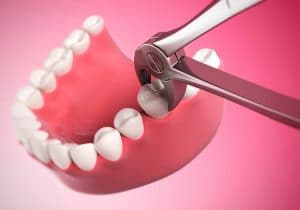While your dentist will always try to save your natural tooth/teeth as much as they can, certain conditions necessitate tooth extraction. This is the process of removal of a problematic tooth/teeth from the jaw. Extractions are advised only if the presence of said tooth hampers your oral health, and no other restorative/preventative measure can be undertaken. While tooth extractions generally cause patients a lot of anxiety, they are relatively comfortable and pain-free.

Table of Contents
When Does One Require A Tooth Extraction?
There are plenty of reasons why an extraction might be recommended for a tooth. Some of which are listed below –
- In cases where a tooth might be severely decayed and nothing can be done to save it. If the tooth remains in the oral cavity it undergoes progression of the decay which in turn causes further complications. These are always extracted.
- If there is a rampant infection in the oral cavity and teeth cannot be preserved by alternative methods, they are recommended for extraction.
- Teeth that are impacted (stuck within the jaw) or those that haven’t erupted properly can cause misalignment, cavities, crowding, and gum disease. These are more common with last molars, also known as wisdom teeth. Impacted teeth also fuel inflammation, infection, and gum disease.
- Patients undergoing orthodontic treatment might have teeth extracted to create space for the alignment of teeth.
- Teeth that are broken or cracked and can’t be restored are also advised extraction.
- Advanced stages of gum disease (periodontitis) witness the loosening of teeth in their sockets. These might be extracted to prevent further issues.
- Hyperdontia is when a patient’s adult dentition starts to erupt before the primary teeth have shed. These milk teeth might be extracted to avoid crowding and to create space for permanent teeth.
- Diseases like HIV/AIDS and treatments like chemotherapy hamper a patient’s immunity severely. In effect, they are unable to fight off infections, necessitating extractions of any tooth with issues.
Tooth Extraction – Procedure
While they might sound scary, dental extractions are pretty routine procedures performed in a dental office. Extractions are of two types –
- Simple Extractions: Teeth to be removed are seen in the oral cavity.
- Surgical Extractions: Impacted teeth, broken teeth, or teeth that aren’t seen in the mouth. These extractions are more invasive and take time to heal.
Before scheduling your extraction, your dentist at Anoka Dental will perform a pretty extensive examination. These will include assessing your oral cavity, taking diagnostic X-rays of the tooth to be extracted. Your medical history will be taken, as certain conditions and medications affect the outcome of tooth extractions.
Local anesthesia is given in simple extractions to numb the soft tissues and surrounding area. With the help of extraction instruments, your dentist will proceed to remove the tooth. You might feel a little pressure, but you won’t feel any pain. Once the tooth has been removed, a sterile gauze will be placed to control bleeding and help in the formation of a blood clot. The entire procedure takes hardly a couple of minutes.
On the other hand, surgical extractions take longer. These are performed by oral surgeons. You might be given nitrous oxide along with local anesthesia. This procedure usually involves cutting open the soft tissues and also removing a bit of bone to access the tooth that has to be removed.
How Long After Tooth Extraction Does The Pain Go Away?
Understandably, before the advent and easy accessibility of anesthetics, tooth extraction was a dreadful experience. (Thank goodness for the current era) Modern-day dentistry makes this procedure pretty pain-free. However, after the anesthesia has worn off, you will feel discomfort and pain for a couple of days. The first 48 hours require strict aftercare – and this timeline is key to preventing any further issues with the tooth socket.
You should expect some bleeding and pain for up to 24 hours after your extraction. This is normal. Extra care must be taken to not dislodge the blood clot that forms in the socket. The pain you feel is easily taken care of by over the counter pain medication.
Most people agree that the pain completely subsides by the third day. However, wisdom tooth extractions take a little while longer to heal, especially if the extraction has been traumatic. Surgical removal of teeth causes damage to the jaw bone too, resulting in extended healing times.
Here’s what you need to do in the first 48 hours after the procedure –
- DO NOT remove the gauze your dentist has placed inside your mouth for a few hours. This will allow the blood clot to form. Afterward, you can remove it, and also change it as often as you need.
- Avoid spitting and rinsing your mouth. This will lead to the clot dislodging from the socket.
- Avoid any hard or hot food or drink. Preference is given to a liquid or soft diet as chewing anything will affect the area that has to heal.
- Avoid using any tobacco products or smoking for up to 3 days following the extraction.
- Your dentist at Anoka Dental will be giving you post-op medication that will include painkillers and might include antibiotics if required. Remember to take them at their appointed times.
- Any post-op swelling can be minimized or reduced by using ice packs on your cheek for 10-20 minutes at a time.
- When you lie down, keep your head elevated to avoid pooling of blood and prolonged healing.
While the healing process may take one to three weeks, your pain should abate within 24-72 hours.
Complications of Tooth Extraction
When a patient fails to follow the post-operative instructions given by the dentist, certain complications may arise. The most common complication of tooth extraction is a dry socket. This is an extremely painful condition that occurs when the blood clot dislodges earlier than it should, leaving the underlying bones and nerves exposed. This can’t be treated at home and professional intervention is imperative.
Some other complications that occur are –
- Uncontrolled bleeding or bleeding that lasts 12 hours or longer.
- Infections
- Redness or inflammation at the surgical site
Any of these signs shouldn’t be ignored and must be checked out by your dentist immediately.
For extraction related queries, or if you simply want to get your teeth checked out, visit us at Anoka Dental today.




